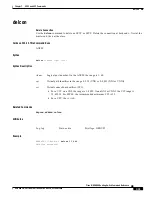
7-37
Cisco MGX 8850 Routing Switch Command Reference
Release 2.0, Part Number 78-10467-04 Rev C0, October 2001
Chapter 7
SPVC and SVC Commands
dspcon
dspcon
Display Connection
Display information about an SPVC. The contents of the display on the AXSM and the PXM45 differ
slightly. On both cards, the dspcon output appears in sections to make the information easier to sort.
Most of the information in the dspcon output comes from addcon execution. See the addcon description
for more information. Also, executing cnfpnni-intf can affect the dspcon output.
Display Connection on the PXM45
On the PXM45, dspcon shows the following connection identifiers:
•
NSAP address, status, and ownership of local and remote ends of the connection. The display shows
whether a particular endpoint is the master or slave.
The provisioning parameters in the display show:
•
Connection type of VPC or VCC.
•
Service type and compliance (for example, UBR for service type and UBR.1 for ATM Forum
compliance).
•
Bearer class (relates to voice traffic and is reserved for future use).
•
Whether continuity checking or frame discard are enabled (see addcon description).
•
Cause of the last failure. This field can also show that no errors have occurred since the connection
was first added by displaying “SPVC Established.” If a failure occurred, the Attempts field shows
the number of times the system attempted to re-establish service. If no failures have occurred, the
Attempts field contains a 0.
•
L-Util and R-Util are the local and remote percent of utilization assigned to the connection.
Currently, the default of 100% is the only value.
•
Cost values for the connection’s route: the two fields in this category are Max Cost and Routing
Cost. The Max Cost is a cost-per-link configured for a service type (such as UBR) through the
cnfpnni-intf command. When you add the SPVC through addcon, you can specify a maximum
routing cost through the maximum cost (maxcost) parameter. The maxcost represents the maximum
cost for an individual connection. The system uses the cost-per-link for the service type and the
maxcost for the connection to determine whether a route costs too much. After the system creates a
route, the total number of links yields the Routing Cost.
The default cost-per-link is 5040, so if a particular service type uses the default and a route consists
of 4 links, the Routing Cost is 20160. If the dspspvc display shows that Max Cost is –1, no limit
was specified through cnfpnni-intf, and the resulting Routing Cost is 0.
•
Broadcast type: point-to-point or multicast.
The Traffic Parameters section shows the standard parameters PCR, SCR, and CDV in the receive and
transmit directions.
















































